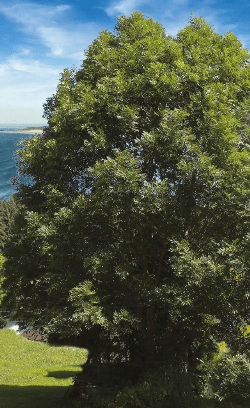It grows naturally in eastern North America. It grows 35-40 m tall in its natural habitat and 15-20 m wide at the crown. It is a wide oval shaped tree. It grows 15-20 m tall in Europe. The bark of the trunk is gray and deeply fissured. Summer green leaves are opposite, compound pubescent with 5-9 leaflets, 10-40 cm long. Leaflets are ovate, 6-15 cm long, dark green on the upper side. In autumn, it turns a color ranging between red and yellow. Flowers are ineffective like Fraxinus excelsior. The fruit is 3-5 cm long, 1-1.5 cm wide and winged. Single winged fruits come together to form clusters. It grows well in temperate climates on deep, fresh loam or clay soils. It is a light tree, but also tolerates partial shade. In Europe, it is mostly used as a road tree or as a solitary tree because of its decorative appearance. It is a fast growing park tree. In America, it is also important in forestry due to this feature.
Fraxinus americana, commonly known as white ash, is native to eastern and central North America. It is found in a wide range of habitats, from moist woodlands to drier upland areas. In the United States, you can find white ash in the following regions:

- Eastern United States: White ash is widespread in the eastern part of the country, including states such as New York, Pennsylvania, Ohio, Michigan, Indiana, Illinois, and parts of the Southeast.
- Central United States: It also grows in the central part of the country, extending from the Great Lakes region down to parts of the Mississippi River Valley.
- Southern United States: While not as common in the southernmost states, white ash can still be found in some areas of the Southeast.
White ash is adaptable to various soil types and can be found in both bottomland forests and upland woods. It is an important species in these ecosystems and is valued for its timber, which is used in various applications such as furniture, flooring, and tool handles.
